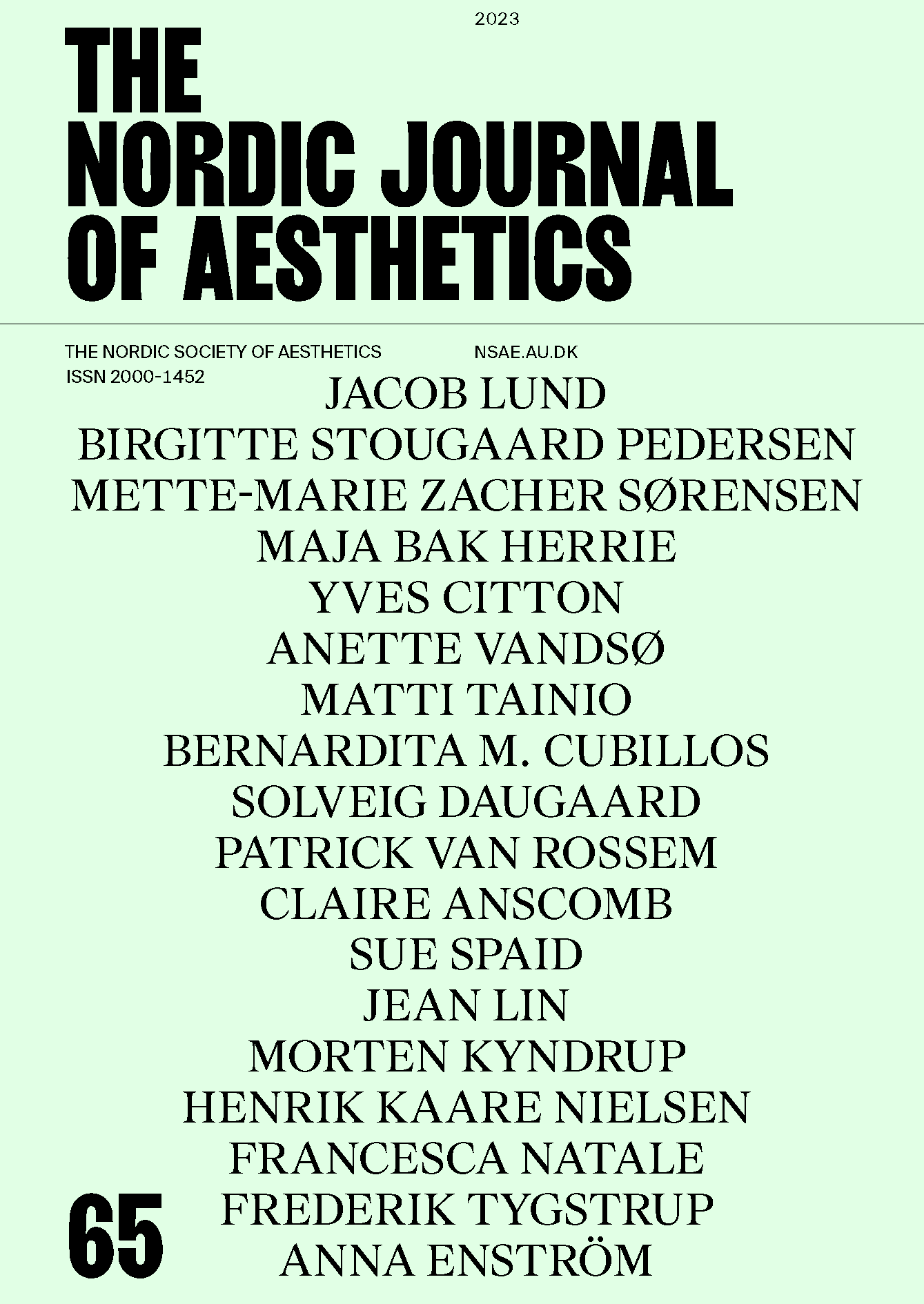Artists and the Public's Attention Since the 1960s: An Exploration of How Artists Seek to Capture the Audience's Attention
DOI:
https://doi.org/10.7146/nja.v32i65-66.140107Keywords:
Mass Audience, Attention, Performativity, Contemporary ArtAbstract
Art historical research shows that artists, especially since the 1960s rise in museum and art gallery attendance do not always trust the audience’s ability to deal with their art. The choice for a performative aesthetic, for example, has also been a method for reasserting rather than—as is often thought—relinquishing artistic control. The article looks at aesthetic strategies developed by artists who desire(d) a more attentive look from their audiences. It considers works made by artists in the sixties and seventies. It is a fact that the appearance of mass audiences goes hand in hand with the creation of artworks that have “attention” as their subject. Secondly, the article takes a look at more contemporary work. Faced with spectators that spend about 28 seconds looking at artworks and reading the accompanying labels, artists are developing strategies that slow spectators down, thus hoping to channel and hold their attention.
References
Mieke Bal, Travelling Concepts in the Humanities—A Rough Guide (Toronto, London: University of Toronto Press, 2002).
Claire Bishop, Artificial Hells. Participatory Art and the Politics of Spectatorship (London and New York: Verso, 2012).
Claire Bishop, “Introduction,” in Participation, ed. Claire Bishop (London: Whitechapel & Cambridge Massachusetts: MIT Press, 2006).
Nicholas Bourriaud, Relational Aesthetics, trans. Simon Pleasance and Fronza Woods (Dijon: les presses du réel, 2002).
Coosje Van Bruggen, Bruce Nauman (New York: Rizzoli 1988),
Jean Butterfield, “Bruce Nauman: The center of yourself,” (1975) in Kraynak (ed.), Please Pay Attention Please.
Yves Citton, The ecology of attention, trans. Barnaby Norman (Cambridge: Polity Press, 2017), 186–189.
David Coggins, “Takeover artist,” artnet, Sept. 2009: http://www.artnet.com/magazineus/features/coggins/ luc-tuymans9-16-09.asp. (Accessed March 8, 2021).
Guy Debord, Society of the Spectacle, trans. Donald Nicholson-Smith (New York: Zone Books, 1994).
Von Hantelmann Dorothee, “Inszenierungen des Performativen in der zeitgenössischen Kunst”, in: Paragrana—Internationale Zeitschrift für Historische Anthropologie, Akademie Verlag, Band 10 (2001): 255–261.
Marcel Duchamp, “The Creative Act,” (1957) in The Writings of Marcel Duchamp, ed. Michel Sanouillet and Elmer Peterson, (New York: Da Capo, 1973).
Robert Enright and Meeka Walsh, “Dan Graham: Mirror Complexities,” Border Crossings, Issue 12, 2010. https://bordercrossingsmag.com/article/dan-graham-mirror-complexities. Accessed March 5, 2021.
Erika Fischer-Lichte, Theater als Modell für eine performative Kultur—Zum performative turn in der europäischen Kultur des 20. Jahrhunderts (Saarbrücken: Universität des Saarlandes, 2000).
Nancy Foote, “Situation aesthetics: impermanent art and the seventies audience,” Artforum, vol. 18, no. 5 (1980).
Dan Graham, “Video as Architectural Mirror and Window,” in Illuminating Video: An Essential Guide to Video Art, eds. Doug Hall, Sally Jo Fifer (New York: Aperture, 1990).
Dan Graham, “Essay on video, television, architecture,” (1979) in Two-way Mirror Power. Selected writings by Dan Graham on his art, ed. Alexander Alberro (Cambridge & London: The MIT Press, 1999).
Sayre M. Henry, The Object of Performance—The American Avant-garde since 1970 (Chicago and London: The University of Chicago Press, 1989).
Thomas Hirschhorn “Quality, No! Energy, Yes!: Thomas Hirschhorn on Why Confrontation Is Key When Making Art for the Public,” Artspace, Nov. 18, 2016. https://www.artspace.com/magazine/art_101/book_report/phaidon-thomas-hirschhorninterview-54368. Accessed March 10, 2021.
Thomas Hirschhorn, “Théatre Précaire for ‘Ce Qui Vient’,” (2009) in Critical Laboratory: The Writings of Thomas Hirschhorn, eds. Lisa Lee & Hal Foster (Cambridge Massachusetts & London, England: The MIT Press, 2013).
Allan Kaprow, “The Artist as a Man of the World,” (1964), in The Blurring of Art and Life, ed. Jeff Kelley (Los Angeles and London: University of California Press, 1996).
Els Maas, “Nieuwe expo van Luc Tuymans bestaat uit één kunstwerk: ‘Dit is een gevecht tegen de dommigheid’,” De Morgen, April 3, 2021. See: https://www.demorgen.be/tv-cultuur/nieuwe-expo-van-tuymans-bestaat-uiteen-kunstwerk-dit-is-een-gevecht-tegendommigheid~b63c0c9b/. Accessed March 8, 2021.
Stijn Meuris, “Stijn Meuris interviewt Luc Tuymans in Bokrijk,” Het Belang van Limburg, July 1, 2008. https://www.hbvl.be/cnt/aid730975/stijn-meuris-interviewtluc-tymans-in-bokrijk/. Accessed March 10, 2021.
Bence Nanay, “Aesthetic Attention,” Journal of Consciousness Studies, 22, No. 5–6 (2015): 96–118.
Brian O’Dohorty, Inside the White Cube. The ideology of the gallery space, (Berkeley, CA and Los Angeles, CA: University of California Press, 1976).
Patrick Van Rossem, “Getting Up-close and Personal with Aunt May and Uncle Jim. Some thoughts on how to deal with your audience in the 1960s,” Performance Research, 22 (3), (2017): 69–76. https://doi.org/10.1080/13528165.2017.1348663.
Willoughby Sharp, “Nauman Interview,” (1970) in: Please Pay Attention Please, ed. Janet Kraynak, (Cambridge Massachusetts, London England: The MIT Press, 2003).
Simmons, D.J and Chabris, C.F., “Gorillas in the mist: sustained inattentional blindness for dynamic events,”Perception, no. 28 (1999): 1059–1074. https://doi.org/10.1068/p2952.
Lisa F. Smith, Jeffrey K. Smith, and Pablo T.L. Tinio, “Time spent viewing art and reading labels,” Psychology of Aesthetics, Creativity and the Arts 11, no. 1 (Febr. 2016): 77–85. https://doi.org/10.1037/aca0000049.
Sandra Stich, Made in U.S.A.: An Americanization in Modern Art, the ‘50s & ‘60s (Berkeley, Los Angeles London: University of California Press, 1987).
Lauren Viera, “An intense Intension,” Chicago Tribune, October 2, 2010.
Downloads
Published
How to Cite
Issue
Section
License
Copyright (c) 2023 Patrick van Rossem

This work is licensed under a Creative Commons Attribution 4.0 International License.
Authors who publish with this journal agree to the following terms:
- Authors retain copyright and grant the journal right of first publication with the work simultaneously licensed under a Creative Commons Attribution License that allows others to share the work with an acknowledgement of the work's authorship and initial publication in this journal.
- Authors are able to enter into separate, additional contractual arrangements for the non-exclusive distribution of the journal's published version of the work (e.g., post it to an institutional repository or publish it in a book), with an acknowledgement of its initial publication in this journal.
- Authors are permitted and encouraged to post their work online (e.g., in institutional repositories or on their website) prior to and during the submission process, as it can lead to productive exchanges, as well as earlier and greater citation of published work (See The Effect of Open Access).




